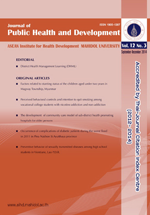Inhibitory activity against pathogenic bacteria of streptomycetes isolated from natural soil resources
Main Article Content
Abstract
Bacterial infections still remain a major public health problem worldwide, particularly caused by multidrug resistant bacteria. Most bacterial diseases can be treated with antimicrobial agents. However, these drugs have been used so widely and so long that the infectious strains have rapidly adapted to resist the drugs, making the drugs less effective. Each year, million people become infected with the antibiotic-resistant bacteria and die as a result of these infections. Hence, discovery of a new drug to combat these infections is urgently needed. Streptomycetes is major group of soil bacteria ubiquitous in natural resources. These bacteria have shown to be a remarkably rich source of natural products, accounting for the production of two-thirds of available antibiotics. Thailand has been a land rich in natural bioresources, including soil microorganisms. Therefore, the objective of this work is to search streptomycetes isolated from Thai natural resources for antibacterial activity. The authors have isolated fifty Streptomyces strains from soils collected from various geographic natural resources of Thailand. The 50 different isolates were determined for antimicrobial activity against various standard strains of pathogenic bacteria using agar plug methods. The infectious bacteria include Enterococcus faecalis, Staphylococcus aureus, Klebsiella pneumoniae, Acinetobacter baumannii, Pseudomonas aeruginosa and Enterobacter aerogenes. The antimicrobial-producing Streptomycesisolates exhibited clear zone of inhibition around their agar plugs containing the colony.
Among the fifty Streptomyces,10 isolates (20 %) (strains SMC2, SMC30, SMC31, SMC47, SMC53, SMC56, SMC95, SMC146, SMC235 and SMC270) showed antimicrobial activities. Five strains (SMC30, SMC31, SMC56, SMC95, SMC270) showed growth inhibition against E. faecalis.Seven strains (SMC2, SMC30, SMC31, SMC53, SMC56, SMC235, SMC270) against S. aureus. Two strains (SMC31, SMC47) against K. pneumoniae. A strain of SMC47 against A. baumannii and E. aerogenes, and a strain of SMC146 against P. aeruginosa. The potent antibacterial agents of Streptomyces candidates were also subject to extraction and assay for the antimicrobial activity against the ESKAPE pathogens. The antimicrobial agent wil be further isolated and purified. These will be useful as chemotherapeutics in the future.


